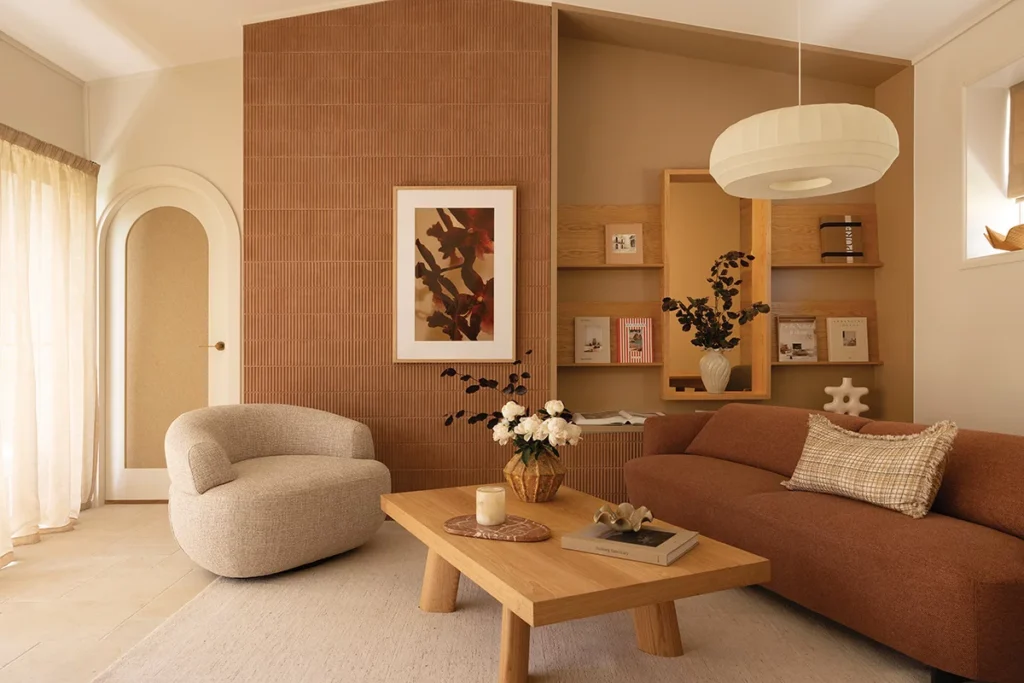Step into your living space and imagine it transformed by the subtle interplay of texture and tone. These elements might seem minute, but they hold the key to creating a harmonious environment that resonates with warmth and character. Through texture and tone, you can elevate your interior from ordinary to extraordinary, crafting a haven that reflects your personal style and comfort.
Textures can awaken your senses by adding layers of depth and intrigue to any room. They engage touch and sight, inviting you to explore each surface. Whether it’s the rough feel of a brick wall or the soft touch of a velvet cushion, texture shapes atmosphere in profound ways.
Color tones bridge the gap between aesthetics and emotion. They breathe life into spaces, influencing moods and perceptions. By balancing soft hues with bold accents, you can curate an ambiance that is not just visually appealing, but also emotionally satisfying. This blend elevates your home to a sanctuary where comfort meets style.
Foundations of Texture and Tone in Modern Interiors
The combination of texture and tone in interiors profoundly influences how spaces feel. By carefully selecting materials and colors, you can create environments that not only look stunning but also evoke desired emotions and moods.
The Emotional Impact of Texture and Tone
Each texture and color within a space can evoke specific emotions and set the tone. Soft fabrics like velvet and cashmere bring warmth and comfort, creating a cozy atmosphere. In contrast, sleek surfaces such as glass and metal provide a modern, clean feel.
Colors also play a vital role. Warm tones like reds and oranges can energize and invigorate, while cooler shades like blues and greens soothe and relax. By blending textures and tones effectively, you can shape the emotional backdrop of any room, influencing how you and your guests experience the space.
Elements that Define Modern Interior Styles
Modern interiors are characterized by simplicity, clean lines, and a focus on function. Materials like steel, glass, and concrete are staples, providing a minimalist and uncluttered look. Natural textures, such as stone and wood, add warmth and a touch of elegance to otherwise stark spaces.
Lighting plays a crucial role, accenting textures and enhancing tonal contrasts. Choose fixtures that highlight the elements of your space while maintaining the modern aesthetic. This balance of texture and tone ensures your interiors resonate with contemporary style while remaining inviting and personal.
Color Harmony and Material Choice
Creating harmony between color and material is essential in interior design. Start with a neutral palette as a foundation, making it easier to incorporate various materials and textures. This approach allows for flexibility in adding accent colors and patterns.
Contrasting materials can add depth and interest to your design. For instance, pairing a soft fabric couch with a metal coffee table can create an engaging contrast. Keep in mind that material durability is important, especially in high-use areas. By focusing on both aesthetic and practical considerations, you can achieve a cohesive design that stands the test of time.
Crafting Balance: Layering Textures for a Harmonious Home
Creating a harmonious home involves thoughtful layering of textures, which can transform your space into a soothing and inviting retreat. Balance is key, whether you’re blending materials or contrasting surfaces.
Mixing Natural and Synthetic Materials
Combining natural and synthetic materials can bring depth to your decor. Think of a jute rug paired with a sleek leather sofa. The contrast highlights the unique qualities of each.
Incorporating a variety of textures—such as wood, metal, and fabric—ensures visual interest. Wooden furniture offers warmth, while metallic elements introduce a modern touch.
Opt for linen or cotton textiles, which breathe life into a room. Balance these with synthetic accents like acrylic or plastic to achieve a modern yet inviting feel.
Contrasting Soft and Hard Surfaces
To strike harmony, blend soft and hard surfaces. Imagine a plush velvet chair against a backdrop of exposed brick. The tactile difference adds intrigue and comfort.
Use soft textiles like cushions and throws to break up stark elements like polished concrete or metal shelving. These cozy pieces invite touch and interaction, softening the overall look.
Layering different textures can also define spaces within a room. A soft area rug over hardwood flooring, for instance, can create a cozy reading nook or a defined dining area.
Creating Focal Points with Tactile Accents
Tactile accents can draw the eye and create points of interest in your interior design. Consider a chunky knit blanket draped over a minimalist sofa or a textured wall hanging above a sleek coffee table.
These elements not only provide visual contrast but also engage the senses. A furry pillow or a woven basket can become conversation starters, allowing you to showcase your personal style. You can experiment here, mixing and matching to find what feels right.
Don’t shy away from bold textures in smaller doses. A ceramic vase with a rough, earthy finish or a metallic lamp with a hammered surface can be the perfect touch to balance elegance with subtle character.
Mastering the Power of Tone: Color Palettes and Light
In modern interiors, mastering tone involves creating a harmonious balance between color palettes and lighting. Neutral shades offer subtlety, whereas lighting choices like warm or cool lights dramatically affect the atmosphere.
Neutral Foundations and Bold Accents
Neutral colors lay the groundwork for elegant environments in modern interiors. These shades, such as soft whites, grays, and beiges, provide a serene and versatile backdrop. Their understated presence allows rooms to feel open and inviting, seamlessly complementing various decor styles.
Bold accents are the stars that add personality to these neutral canvases. Colors like deep navy, rich emerald, or vibrant mustard can be woven into the room through statement pieces. Consider accent walls, cushions, or artwork to make impactful statements without overwhelming the senses.
The Role of Lighting in Enhancing Mood
Lighting is essential to setting the mood in any space. The choice of light, whether it’s natural daylight or artificial, can influence emotions and perceptions of space. Soft, warm lighting creates a cozy and inviting atmosphere, ideal for family rooms or bedrooms.
In contrast, bright, cool lighting energizes and aids concentration, making it suitable for workspaces or kitchens. Dimmer switches offer flexibility, allowing you to easily adjust lighting levels to match different occasions or moods. The strategic placement of lamps and fixtures further draws attention to key design elements.
Curating Seamless Transitions Between Spaces
A unified flow between rooms is important in creating a cohesive home environment. This is achieved by maintaining consistent color tones and lighting styles throughout. By using a base neutral palette, transitions feel natural and effortless.
Gradual changes in color from one room to another help in maintaining this flow while adding slight variations. Use similar lighting fixtures or color temperatures across interconnected spaces to avoid jarring contrasts. This strategy ensures areas like hallways and living spaces feel interconnected yet distinct.
Personalizing Your Space Through Texture and Tone
Transform your home into a reflection of your personality by choosing the right textures and tones. Discover how artistic details, mindful choices in textiles, and adapting to seasonal changes can make a meaningful difference.
Expressing Personality with Artistic Touches
Adding personality to your space with artistic details is an exciting endeavor. Choose fabrics and materials that speak to your tastes. For example, vibrant throw pillows or textured wall hangings can instantly add charm.
Mixing different textiles, such as velvet with linen, creates a dynamic setting. Consider using artwork with colors that pop. Whether it’s a colorful rug or a handmade vase, these touches create a space that feels uniquely yours. Don’t hold back on expressing your individuality through these artistic elements.
Sustainable and Ethical Choices for Textiles
Being thoughtful about where your materials come from can significantly affect both the aesthetic and ethical footprint of your home. Opt for textiles that are sustainably sourced or made from recycled materials. This approach not only supports ethical production but also adds a layer of meaning to your decor.
Natural fibers like organic cotton or hemp are perfect choices. Look for certifications from reputable organizations to ensure the sustainability of your selections. These choices help you craft a home that not only looks good but also aligns with values that are important to you.
Seasonal Changes and Refreshing Your Home’s Look
Refreshing your home with the changing seasons can invigorate the atmosphere. In autumn and winter, opt for warmer tones and cozy textures.
During warmer seasons, swap out heavy fabrics for lighter ones and consider pastel colors. This not only updates the look but also enhances comfort throughout the year. Beautiful rug designs inspired by nature and craft—such as those featured on Land of Rugs—can further elevate your space and connect it to natural themes.
Conclusion
Texture and tone may be subtle, but they shape the atmosphere and character of your home. By thoughtfully layering materials, balancing color palettes, and using lighting to enhance mood, you create spaces that feel both stylish and deeply personal.
These elements work together to bring warmth, depth, and harmony to every room. Embrace their power, and let your home reflect comfort, modern elegance, and your unique sense of style.


